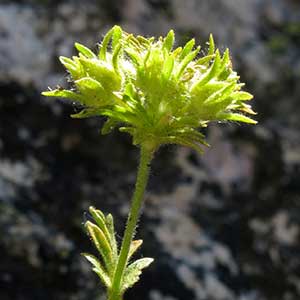Ivesia muirii
Ivesia longibracteata
granite mousetail, Muir's ivesia
Castle Crags ivesia, longbract mousetail
usually ± erect, sometimes nearly prostrate, 0.5–1.5(–2) dm.
ascending to erect, 0.3–1.2 dm.
very tightly cylindric (mousetail-like, with individual leaflets scarcely distinguishable), 2–5(–10) cm; sheathing base densely strigose abaxially;
petiole 0.2–0.8(–1) cm, hairs 0.5–1.5 mm;
leaflets 25–40 per side, 0.4–1 mm, densely sericeous, glands obscured, lobes 2–5, obovate or oval to orbiculate, apex not setose.
weakly planar to loosely ± cylindric, (0.5–)2–4(–6) cm; sheathing base glandular abaxially, otherwise glabrous;
petiole 0.5–2 cm, hairs 0.2–1 mm;
leaflets 5–6 per side, 2–6 mm, ± short-hirsute, glandular-puberulent, lobes 2–7, oblanceolate to spatulate or obovate, apex not setose.
(0–)1–2, paired if 2.
1–3, not paired.
10–30-flowered, 1–2(–3.5) cm diam.;
glomerules usually 1.
3–14-flowered, 1–2.5 cm diam.;
glomerules 1.
0.3–2(–3.5) mm.
1.5–6 mm.
5–6 mm diam.;
epicalyx bractlets oblong to obovate, 0.5–1 mm;
hypanthium shallowly cupulate, 0.5–1(–1.5) × 1.5–2.5 mm;
sepals (1–)1.5–2.5 mm, acute;
petals yellow, linear to oblanceolate or narrowly oblong, 1–2 mm;
stamens 5, filaments 0.3–0.6 mm, anthers yellow, 0.4–0.6 mm;
carpels 1–4, styles 0.7–1.2 mm.
8–10 mm diam.;
epicalyx bractlets linear to narrowly lanceolate or elliptic, 2.5–5 mm, longer than sepals;
hypanthium shallowly cupulate, 0.5–1 × 2–3 mm;
sepals 1.5–2.5 mm, ± acute;
petals pale yellow, linear to narrowly oblanceolate, 1.5–2.5 mm;
stamens 5, filaments 0.7–1.3 mm, anthers yellow, 0.5–0.8 mm;
carpels 6–11, styles 1–1.5 mm.
grayish brown, mottled with red, 1.6–2 mm.
cream to light tan, 1.2–1.5 mm.
Ivesia muirii
Ivesia longibracteata
Ivesia muirii is known from alpine areas in the Sierra Nevada. It is one of the more distinctive species of the genus, in its silvery mousetail-like leaves and usually tightly capitate inflorescences. Putative hybrids are known with I. lycopodioides (D. D. Keck 1938) and I. pygmaea (Center Basin area of Tulare County).
(Discussion copyrighted by Flora of North America; reprinted with permission.)
Of conservation concern.
Ivesia longibracteata is known only from the Castle Crags area of Shasta County. The epithet alludes to a diagnostic characteristic unique in the genus: the epicalyx bractlets are longer than the sepals. The plants grow on vertical rock faces, a habitat more characteristic of sect. Setosae; however, the stems are ascending to erect and do not form hanging clumps, and the pedicels are not curved in fruit.
(Discussion copyrighted by Flora of North America; reprinted with permission.)


